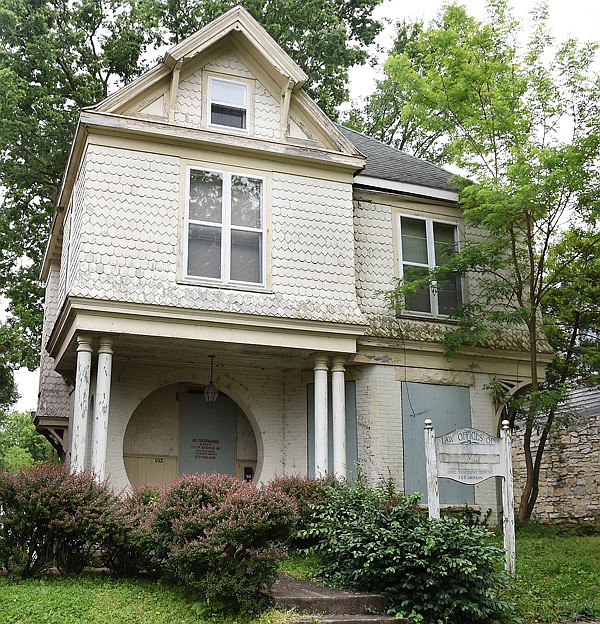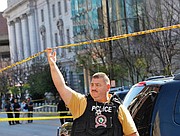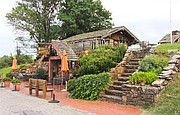Four of the five Jefferson City properties being considered for initial attention in the East Capitol Avenue Urban Renewal Plan are steeped in stories and events that shaped the Capital City, as well as the state of Missouri, but have not been designated as historic City Landmarks.
The current nomination process requires property owners to apply for the Landmark Award.
103 Jackson Street
The three-story home with a unique circular "keyhole" entry between double porch pillars likely was a dream home for Sarah "Mildred" Parsons.
At age 22, she married her second husband, Austin Standish, an Irish immigrant working as a civil engineer for the Pacific Railroad, who built the home next door to his in-laws.
The Queen Anne-style brick and frame home stands at 103 Jackson St.
Mildred was born in 1834 in Charlottesville, Virginia, to G.A. and Patience Parsons. Her father had worked for President Thomas Jefferson at Monticello and moved to the namesake city in 1839, according to her obituary on May 24, 1919, in the Jefferson City Democrat Tribune.
The Parsons family enjoyed a spacious setting for their home overlooking the Missouri River and featuring a stone stairway to the river's edge, prior to the installation of Jackson and State streets, according to the Daily Capital News on March 20, 1942.
Before her marriage in 1857, three of her sisters had died, including Mary Ann, who married a nephew of Jefferson.
The Standishes had two sons - Richard and Austin - before the Civil War began. Their youngest son, Monroe, was born in January 1862. By that December, Mildred's youngest brother, Gustavus Adolphus Jr., died in Van Buren, Arkansas, after enlisting at age 16.
Her other brother, Monroe Mosby (M.M.), had distinguished himself early in the military, commanding a company of mounted volunteers from Cole County in the Mexican War. He commanded the 6th Division of the Missouri State Guard before being promoted to Brigadier General in the Confederate Army.
Mildred's husband, Austin, also joined the 6th Division, eventually rising to the rank of colonel and served on Gen. M.M. Parson's staff.
Standish served from the beginning of the war and was once wounded when his horse was shot from under him, and his life was saved at the battle of Wilson Creek by his watch, which was badly crushed by a bullet meant for him.
The 1942 newspaper reprinted a letter in Mildred's own words, detailing her last visit with her husband and brother inside the Confederate lines.
Following the election of Lincoln to his second term, her father encouraged Mildred "to go south and try to persuade my husband Col. Standish to leave the Confederate Army and take a position of less danger than that of Chief of Staff to my brother Gen. Monroe M. Parsons," she wrote.
She braved travel through enemy lines with her three young sons in tow. After weeks aboard boats, trains and wagons, she reached his camp in Arkansas. For a southerner crossing through enemy lines, Mildred Standish found courtesy and hospitality.
"In view of the fact that I had not asked any favors, good fortune meeting me at every point was most remarkable," she said. "Surely a kind providence guided me to find friends among strangers to help me through the difficult places."
From Arkansas, she had traveled with her husband and brother to their Louisiana camp, where they were for the last days of the Confederacy and when word of Confederate Gen. Robert Lee's surrender arrived.
Upon receiving that news, Gen. M.M. Parsons and his brother-in-law, Col. Standish, with other Confederate officers chose to seek better futures in Brazil.
Mildred wrote the officers in particular felt anxious and uncertain about the future, including her husband. They "decided at once to leave the country believing that better opportunities of practicing their professions could be found elsewhere," she wrote.
With her young sons, Mildred returned from Shreveport, Louisiana, to Jefferson City.
"While on their way south, both Gen. Parsons and Col. Standish were cruelly murdered," Mildred's obituary said.
The soldiers still wearing their Confederate uniforms were attacked by Mexican soldiers June 10, 1865, near Chino, Mexico, by the San Juan River.
"At first, the bloody deed was supposed to have been committed by guerrillas, but it was afterwards found that they were soldiers," noted the May 5, 1875, Troy Herald. "It was a fiendish massacre, and several noble men were butchered."
Standish was remembered "as gallant an Irishman as ever drew a sabre or mustered a squadron."
"Legend surrounding the Standish house tells that Mildred, refusing to believe reports of the deaths of her husband and brother in 1865, kept a burning candle for them in the front window waiting for their return," according to the Historic City of Jefferson's "Capitol Avenue Historic District."
At the same time, she had a young family to care for. In addition to serving as matron of the School for the Blind in St. Louis for more than 30 years, Mildred also won restitution from the Mexican government.
In September 1875, she was awarded $40,000 in gold plus replacement of the $1,500 Standish had with him at the time of his murder. Her nephew and another Missouri widow also won claims of $50,000 each.
"Although crushed by the double tragedy which came to her as the result of the war and it's subsequent financial responsibilities, Mrs. Standish faced the future with a grace and dignity which caused her to be one of the most beloved personages of the city," the 1942 newspaper said.
Mildred was an honorary member of the Confederate veterans M.M. Parsons Camp and was one of the oldest members of Grace Episcopal Church at the time of her death.
In February 1919, just three months before her death at her niece's home in St. Louis, Mildred was one of 35 patients rescued from a fire at the St. Mary's Catholic Hospital.
She is buried at Woodland-Old City Cemetery, sharing a headstone with her son, Richard, a Cole County clerk. Sons - Austin, a physician, and Monroe, involved in the wholesale drugs business - also are buried there, as well as memorial stones for her husband, brother and several other Parsons family members.
108 Jackson Street
An eye-catching example of Queen Anne architecture, 108 Jackson St. was built about 1890.
The brick 2 1/2-half-story home features several decorative elements, including the pyramidal tower, according to the Capitol Avenue Historic District nomination to the National Register of Historic Places.
The north corner boasts a rounded two-story bay, and the center of the gable has a three-light round window. The first floor also features a wrap-around porch that bows out around the rounded bay and curves around the southeast corner tower.
By the late 1960s, the property was used as blended office space and residential.
Employees of state offices, International Shoe Company and others lived there for short periods of time.
Roy and Maye Ottinger bought the property from the estate of Ethel Gibler in 1969.
Born in 1891, Gibler studied at Central Missouri State College and returned to her hometown to work at Exchange National Bank before retiring in 1956.
Gibler was a member of First Presbyterian Church and active in the Charles Still Hospital Guild. She died suddenly in a two-car collision in 1966.
Maye Ottinger hosted social gatherings with the Cole County Republican Women's Club and the First Baptist Church Women's Missionary Union.
It also was the headquarters for the State Association of Mentally Retarded Children, organized in 1954.
The voluntary organization established and coordinated local associations, provided programs and services consultation and instituted special services to the "mentally retarded," as well as providing preschool classes, diagnostic evaluations, social and recreation activities, vocational training, counseling and public information.
The Ottingers sold the property to Barbara and Betty Buescher in 1975.
Jewell Pratt lived there for about a decade beginning about 1985.
She served the Jefferson City public schools as nurse for 35 years.
Pratt was born in 1908 to Judge John and Maude Leslie. She was a charter member of the Jefferson City Symphony Orchestra, playing both the violin and viola, and she performed with the St. Louis Symphony at the Capitol dedication in 1924.
She was among the first graduating class from Jefferson City Junior College, and she went on to become a registered nurse, working for a time in St. Louis at St. Luke's Episcopal Hospital and Nurses Home.
She married Burt Pratt, who died in 1945, leaving her to raise three children.
Pratt was active at First Baptist Church and involved with Missouri State Nurses' Association, Delta Kappa Gamma Educators' honorary, fellow of the American School Health Association and invited member of Royal Society of Health in London.
She left her mark on the Capital City's health by organizing health parades, an annual tradition through the mid-20th century, as well as organizing immunization clinics to vaccinate Cole County children from polio, typhoid and diphtheria.
Pratt also organized aid to provide eyeglasses and dental services for needy children.
401 East Capitol Avenue
An "orator of distinction, eloquent and logical in his arguments," according to the Missouri Bar Association, Attorney General Daniel McIntyre called 401 E. Capitol Ave. home while he argued one of the greatest legal victories for the state.
In the famous litigation against the Hannibal and St. Joseph Railroad, McIntyre fought through the federal courts and saved the state more than $3 million.
McIntyre first arrived in Jefferson City to complete the state Senate term of Charles Hardin, newly elected governor in 1874 and under whom McIntyre had studied law in Audrain County.
He was elected in his own right to represent Audrain County in the statehouse from 1876-80. He won the statewide election to attorney general for the 1881-85 term and chose to remain in Jefferson City, where he continued his law practice, as well as serving as president of Merchants Bank.
In 1886, he was re-elected to the statehouse, this time representing Cole County until 1891.
Born in Callaway County in 1833, McIntyre was raised in Mexico and attended Westminster College, where he graduated in absentia in 1861, as he was already an officer in the Missouri State Guard.
McIntyre was elected captain of Company A in the 1st Infantry Regiment, which formed from Callaway County and saw action at Carthage and Springfield. He was severely wounded in the jaw at the Battle of Wilson's Creek.
He returned home to recuperate but was captured Dec. 19, 1861, at Blackwater River near Milford and sent to Alton Prison (Camp Chase and Johnson's Island Prison). He was exchanged at Vicksburg, Mississippi, in September 1862.
After his release, he enlisted in the regular Confederate army, serving as a lieutenant in Company K of the 10th Regiment Missouri Cavalry under Confederate Gen. Sterling Price until the surrender at Shreveport, Louisiana.
McIntyre married Susan Simpson in Adams County, Illinois, in March 1866 and returned to Salt River near Mexico as a farmer until 1871, when he took up law.
He was elected Audrain County prosecuting attorney from 1872-74.
For about 10 years, the McIntyres called Jefferson City home. They made their mark, building the Italianate, three-story, yellow brick home at 401 E. Capitol Ave. about 1883.
After his last term representing Cole County in the statehouse about 1891, he returned to Mexico after his war wound caused him to go blind.
By 1902, his wife, Susan, had been judged insane and was committed to the Fulton State Hospital.
Upon his death in 1910, the Mexico Ledger described him as "a man who for 40 years was active in public life in his city, county and state life, public and private, was without a blemish, and he was honored and respected for his ability and integrity."
500 East Capitol Avenue
Built to host prominent guests for elaborate parties, Ivy Terrace at 500 E. Capitol Ave. still retains most of its grand designs 120 years after being built by local architect Charles Opel.
The striking, red home "once served as the center of gaiety prevailing in Jefferson City and throughout the country in the 1890s," according to the Dec. 3, 1967, Sunday News and Tribune.
The home was built in 1893, following the election of Lon Stephens, of Boonville, to the state treasurer's office.
"Records of the period described the many parties held in the home with dancing on the third-floor ballroom and guests including state officials, prominent local residents and relatives from the Boonville area," the newspaper said.
The entertaining tradition began by Stephens and his wife, Maggie, continued when they sold to local druggist and civic leader Gustavus A. Fischer in 1903. The Stephens only lived in the home for three years before he was elected governor and moved into the Governor's Mansion, according to the 1990 National Register of Historic Places nomination.
Distinguished by its open-air turret and extensive wrap-around porch, "Ivy Terrace is one of the most intact Queen Anne representatives of this architectural style in Jefferson City," according to the Historic City of Jefferson's "Capitol Avenue Historic District."
It retains eight hand-carved fireplaces complete with Italian tile, art glass windows and the grand entry oak staircase.
The national register nomination said its "most significant characteristics are its rounded tower, wrap-around porch, high and irregular roof, fish scale shingles and asymmetrical facade."
"All of Opel's homes were good examples of Queen Anne style, but few have survived - Ivy Terrace is the only one substantially unaltered," the nomination said.
Most of the "historic east" was influenced by Opel, a 1992 Urbana architectural survey said.
He designed several prominent buildings in town including several at Lincoln University, First Methodist Church, First Baptist Church, Second Baptist Church, the Tweedie home at 601 E. High St., parts of the Missouri State Penitentiary and other buildings in Russellville and California.
Born in 1857 to immigrants Adam and Charlotte Opel, he learned his trade from his father, a successful contractor who arrived from Bavaria in 1852. Charles Opel was a cabinet maker before going into partnership with his father in 1882.
Later he partnered with another local architect, Fred Miller, with an office in Columbia by 1898 and expanded further by 1911 to offices in Kansas City and Springfield, where he partnered with his son-in-law A.N. Torbitt.
Opel also was active in the community. By 1900, he was the business manager and treasurer of the Missouri Illustrated Sketch Book Company, vice president of the Commercial Club (forerunner to the Chamber of Commerce), director of the Town Mutual Fire Insurance Company, treasurer of the First Church of Christ Scientists and state president of the Single Tax League.
The Jefferson City sketchbook said he was a fluent writer and speaker, "taking an interest in every measure to its artificial beauty, as well as other means material progress."
Opel married Myrtle Hughes in 1881. They had eight children - six, including an adopted daughter, who were still alive in 1915 following his death due to kidney failure in Kansas City.
The Opels' teenage daughter Jessie died in 1901 when her clothing caught on fire from a lamp near where she was curling her hair.
Opel's grand architectural achievement at 500 E. Capitol Ave. served the 18th state treasurer for three years.
Stephens, born 1855 in Boonville, was educated at Cooper Institute, Kemper Family School, and Washington and Lee University. He was appointed March 1890 by Gov. D.R. Francis to fill the term of Edward Noland and then elected in 1892.
He was elected governor in 1896 on the Free Silver platform, serving one year during which time the State Fair was established in Sedalia.
Ivy Terrace passed in 1903 to Gustavus and Jennie Fischer, who married in November 1889. Jennie was the granddaughter of Dr. Bernard Bruns, founder of Westphalia and pioneer physician and civic leader.
In 1887, Fischer founded the G.A. Fischer Drug Company at 105 E. High St., which he handed down to his son Clifford Hess Fischer. He also helped Fred Ott establish East End Drug at 700 E. High St.
The Fischers called Ivy Terrace home from 1903-48. Gustavus died in 1933, and Jennie remained there until her death in 1947.
Jefferson City "loses one of her best known, most highly respected and successful business men, druggist and bankers," the Daily Capital News reported April 29, 1933.
Fischer graduated from the Jefferson City schools and then from the St. Louis pharmacy school. He started as clerk at J.R. Riddley Drug Store, which he later bought and renamed.
In 1902, Fischer was a "prime mover" in organizing the Central Missouri Trust Company, his obituary said. Upon Sam B. Cook's death in 1931, he became chairman of the board of directors.
"He inspired the Central Missouri Trust Company building and was the leading spirit and financial genius that gave Jefferson City this outstanding office and business building," the Capital News reported.
Fischer was involved in the opening of the Jefferson City Country Club in 1922 and organizing the Capitol Telephone Company at the turn of the century.
Mary Woods bought the home in 1948, where she operated the Mariwood College of Beauty Culture until 1966, when it was sold to Thomas Whitecotton, who lived there until about 1987 with his wife, Dee.
Whitecotton "restored the building to its original splendor," a 1967 Sunday News and Tribune article said.
He was one of the original members of the Missouri Highway Patrol, retiring in 1965 after 34 years. He was involved in a major gun battle with the infamous Barrow Gang in Platte County July 20, 1933, according to his 1987 obituary in the News Tribune.
Whitecotton was appointed warden of the Missouri State Penitentiary and chairman of the Penal Commission in 1945. He was appointed director of the Department of Corrections in 1953.
He was born in 1905 in Ralls County, coming to Jefferson City from Monroe County.
In the community, Whitecotton served as a Ward 2 councilman and president of the Society of Retired State Highway Patrol Employees and member of Immaculate Conception Church. The current Jefferson City Police Station was named in his honor.




